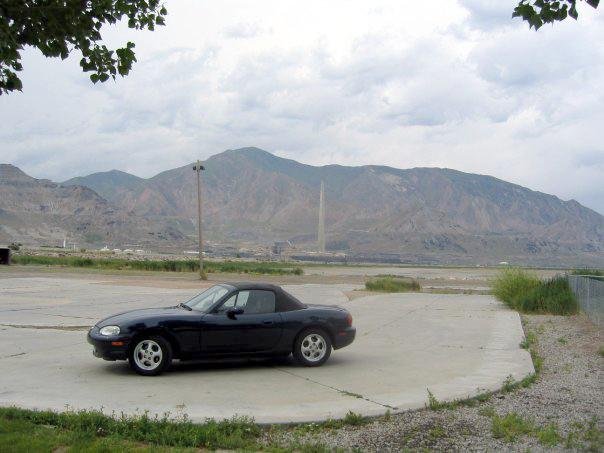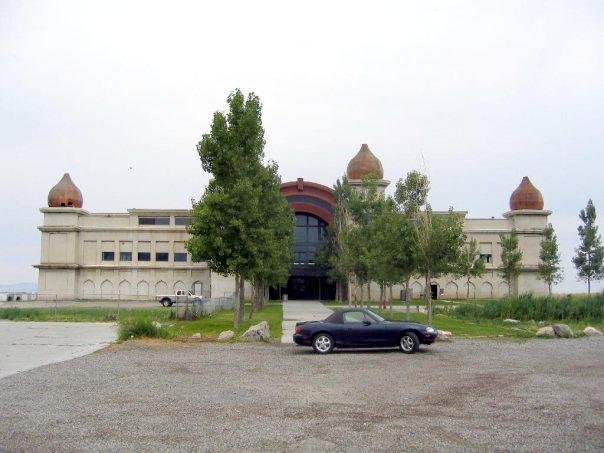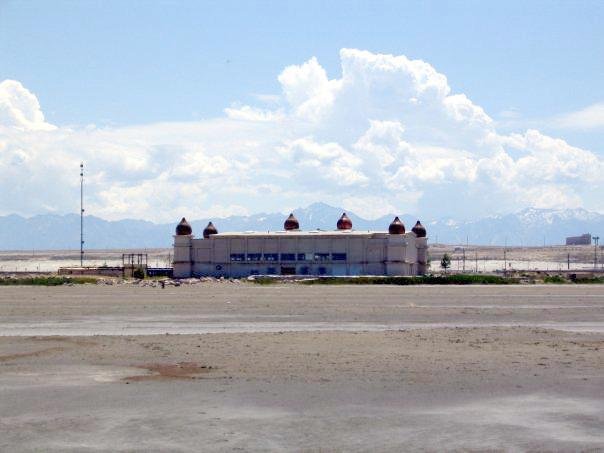Adventures & Explorations #130
Moving right along to June 2004, in which I introduce my next car (after the Jag committed suicide) - a 2000 Mazda Miata. Picked up this little cutie using the insurance $$ from the totaled Jag. But that only paid for HALF of this car. Had to finance the other half.
Anyway, one of the first road trips (of many) in the Miata was up to visit my Mother and that half of the family in the Salt Lake City area. And one of the places we visited during that particular trip was a cool old building designed by my architect Uncle - a place called "Old Saltair".
This "Old Saltair" was actually the third version, built in 1981. Previous versions were built in 1893 and the 1920s. But this version always held a special place in our family's heart, due to my Uncle's involvement. My grandmother used to love going there.
Here's more of the history from Wikipedia:
Saltair, also The SaltAir, Saltair Resort, or Saltair Pavilion, is the name that has been given to several resorts located on the southern shore of the Great Salt Lake in Utah, United States, about fifteen miles from Salt Lake City.
Saltair I
The first Saltair, completed in 1893, was jointly owned by a corporation associated with The Church of Jesus Christ of Latter-day Saints and the Salt Lake & Los Angeles Railway (later renamed as the Salt Lake, Garfield and Western Railway), which was constructed for the express purpose of serving the resort. Saltair was not the first resort built on the shores of the Great Salt Lake, but was the most successful ever built. It was designed by well-known Utah architect Richard K.A. Kletting and rested on over 2,000 posts and pilings, many of which remain and are still visible over 110 years later.
Saltair was a family place, intended to provide a safe and wholesome atmosphere with the open supervision of Church leaders. While some of the other resorts in the area were seen as "spiritually bleak", a young courting Mormon couple could visit Saltair without worrying about gossip. Trains left from Salt Lake City every 45 minutes, and so long as the boy got the girl home at a reasonable time after the train arrived, parents weren't worried – in part because, from the moment of arriving at the station before the outing until they left the station coming home, they were usually never out of sight of trusted members of the community. More than once, a couple on the way home found themselves in the same car as their parents, who themselves had been dancing at Saltair.
Intended from the beginning as the Western counterpart to Coney Island, Saltair was one of the first amusement parks, and for a time was the most popular family destination west of New York. The church finally sold the resort in 1906.
Saltair II
The first Saltair pavilion and a few other buildings were destroyed by fire on April 22, 1925.[3] A new pavilion was built and the resort was expanded at the same location by new investors (again, mostly prominent Mormons), but several factors prevented the second Saltair from achieving the success of its ancestor. The advent of motion pictures and radio, the Great Depression, and the interruption of the "go to Saltair" routine kept people closer to home. With a huge new dance floor – the world's largest at the time – Saltair became more known as a dance palace, the amusement park becoming secondary to the great traveling bands of the day, such as Glenn Miller. Though Saltair showed motion pictures, there were other theaters more convenient to town.
In addition, the first Saltair had benefited from its location on the road from Salt Lake City to the Tooele Valley and to Skull Valley, which in the late 1800s was home to Iosepa, a large community of Polynesian Mormons. Being near a major intersection, Saltair also served as the first (or last) major facility on the road, making it a popular resting area for those travelling by horseback or wagon. When Saltair was rebuilt, however, this traffic was all but gone. Part of the reason was the advent of automobiles, bus and train service to the Tooele Valley, but the other cause was the abandonment of Iosepa, as Polynesians went to homes in the Salt Lake Valley or the community forming around the new LDS Temple in Laie, on Oahu in the Hawaiian Islands.
Saltair thus had to survive solely against strong competition, and in a dwindling market. Disaster struck in 1931, in the form of a fire that caused over $100,000 in damage, then again in 1933 as the resort was left high and dry when lake waters receded (forcing the construction of a miniature railway to carry swimmers between the resort and the water). Saltair was forced to close during the Second World War, which forced the rationing of fuel and other resources while it took many of the resort's paying customers – and vital employees – out of Utah. Reopening after the war, the resort found the same situation that it had faced in the 1930s. There were so many other entertainment options, closer to home, and the public was no longer in the habit of going "all the way out there". The resort closed in 1958, causing the railroad to cease passenger operations at the same time.
Attempts over the next decade to breathe new life into the resort finally ended in November 1970, when an arson fire was set in the center of the wooden dance floor, destroying the main Saltair pavilion. A previous arson fire in September 1967 had destroyed the concourse, entry gate, concession stands and various other support structures but spared the main building.
Saltair III
Proximity to Interstate 80, plus new population expansion into the Tooele Valley and the western Salt Lake Valley, prompted the construction of a third Saltair in 1981. The new pavilion was constructed out of a salvaged US Air Force aircraft hangar and located approximately a mile west of the original. Once again the lake was a problem, this time flooding the new resort only months after it opened. The waters again receded after several years, and again new investors restored and repaired and planned, only to discover that the waters continued to move away from the site, again leaving it high and dry.
Concerts and other events have been held at the newest facility, but by the end of the 1990s, Saltair was little more than a memory, too small to compete with larger venues that were closer to the public. While there is occasionally activity now and then, through most of the early twenty-first century, the third Saltair was all but abandoned. In 2005 several investors from the music industry pooled together to purchase the building and are now holding regular concerts there. Bands, singers, and DJs such as George Clinton, Green Day, Marilyn Manson, Rob Zombie, Ruth Mendoza, Bob Dylan, The Used, Dave Matthews Band, The Black Crowes, Deadmau5, Tiësto, DJ Baby Anne, Evanescence, Panic! at the Disco, Children Of Bodom, and other notable hip-hop music and rock music acts have all performed there recently. On February 18, 2011, Kesha performed to a sold out crowd on her Get Sleazy Tour.
Remnants
Relics of the age of the Great Salt Lake resorts are nearby, and can be seen from the highway. Until recently, the most noticeable of these was the skeleton of car "502", one of the Salt Lake, Garfield & Western's interurban rail cars that sat beside the ruins of an old powerhouse. The powerhouse once fed lights and roller coasters at the entrance to the original Saltair. The rail car was removed on February 18, 2012, by the property owner for safety concerns. Rows of pilings snake outward toward the lake, all that remains of the railway trestle and pier that once led to the earlier Saltair resort. The surviving buildings of Lake Park, one of Saltair's neighbors, were moved to a new site thirty miles away, where the Lagoon Amusement Park has grown around them.
The Salt Lake, Garfield & Western still exists as a common carrier shortline railroad, providing switching service in the Salt Lake City area. However, the tracks no longer reach to the resort itself.
In popular culture
Saltair has occasionally been used as a backdrop for movies. Key scenes of the 1962 horror cult film Carnival of Souls were shot in Saltair II. The opening scene of the 1990 film The Giant Brine Shrimp was set in Saltair and the lake.[5] The 1993 film Josh and SAM features a scene at the then dilapidated Saltair III, showing the exterior and interior. A 1960s photo of Saltair II was also featured on the cover of the bootleg Beach Boys album, Unsurpassed Masters, Vol. 19.
The Pixies's 1991 song "Palace of the Brine" is a reference to Saltair.



I see visions of "Carnival Of Souls"!
Ha-ha! :-)
The place looks abandoned and in the middle of nowhere, makes me remind of the Aral Sea somehow. Upvoted and resteemed, for your support!
Thank you. And yes, it was mostly abandoned at that point. But it's come back to life a little bit since then.